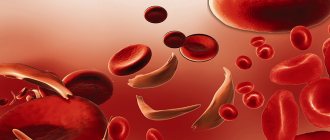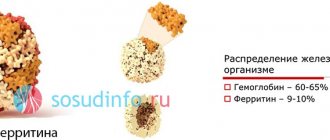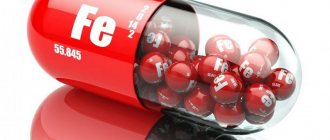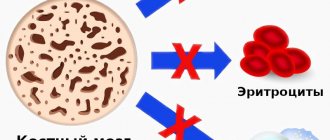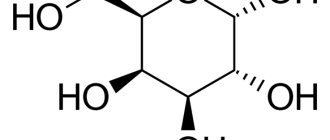Anemia is an unpleasant phenomenon. It is recognized mainly through blood tests. But at the same time, it can give negative manifestations in the form of certain symptoms. In fact, doctors note, anemia can kill a person, although it is often underestimated.
Anemia is understood as a decrease in hemoglobin in the blood, which is conventionally divided into several degrees, the last of which is severe and life-threatening. There may be many reasons for this condition, but the result for the body is not the best in any case. Often, parents who monitor the condition of their children are concerned about iron levels in the blood. And in adult life, many people forget about this parameter. And completely in vain.
AiF.ru was told by therapist, professor, head of the Outpatient Physician Regional Public Organization and the Institute of Outpatient Therapy, Honored Scientist of the Russian Federation, Arkady Vertkin about why anemia is deadly and how exactly it kills, as well as how to recognize it in time .
Anemia - what is it and how dangerous is it?
This disease is also called anemia. This is a clinical-hematological syndrome that can occur as a consequence of one or another pathology. Hemoglobin protein is synthesized in the bone marrow with the participation of iron and is a component of erythrocytes - red blood cells. It delivers oxygen to the tissues and also helps to utilize carbon dioxide, delivering it to the lungs.
Such an important function easily explains the dangerous consequences of anemia. Firstly, even in conditions of a lack of iron in the diet, the body will fight anemia with all its might: first there will not be enough iron in the tissues and organs, and only lastly in the blood. This means that anemia often accompanies serious bone marrow diseases, tumors, and severe hematological diseases. It is important to pay attention to anemia as early as possible for this reason.
Secondly, a decrease in hemoglobin levels can lead to the following consequences:
- weakening of protective forces and increased susceptibility to aggressive environmental factors;
- decreased physical endurance and tolerance to intellectual stress;
- high risks of developing heart disease;
- high risks of developing purulent-septic processes.
Pregnant women deserve special attention. Anemia during pregnancy can lead to a high probability of spontaneous abortion, fetal malnutrition and intrauterine growth retardation, the appearance of hypoxia, and discoordination of labor. Physiological blood loss during childbirth or during a cesarean section will not cause complications in a healthy woman, but in an expectant mother with anemia it can also cause serious consequences.
Mechanism of development of secondary pathology
The mechanism of development of the disease is multifaceted; it combines the action of several factors that provoke an anemic state.
Increased body temperature decreases iron absorption
There are three main pathological mechanisms:
- Inhibition of erythropoiesis processes (tumor cells displace blood cells from the bone marrow).
- Decreased vital activity of the red bodies (direct mechanical damage to blood components, hyperplasia of the erythroid germ).
- Disorder of iron metabolic processes (excessive consumption of the microelement by bacterial cells, as well as chronic bleeding that disrupts its synthesis).
In the mechanism of pathology formation, a certain role belongs to malignant neoplasms, which, during decay, release toxic substances that inhibit the activity of the hematopoietic system.
Symptoms of anemia
Symptoms of anemia and treatment options may vary in patients of different age groups, gender, and general health. The most characteristic signs are the following:
- pallor of the skin (from white to yellowish) and mucous membranes;
- hair loss (not patchy baldness, but uniform hair loss);
- brittle nails, changes in the structure of the nail plate, suddenly appearing white spots on the nails;
- change in taste sensations, burning sensation on the tongue;
- cracks in the corners of the mouth;
- menstrual cycle disorders in women;
- decreased physical activity, resistance to physical activity;
- muscle weakness;
- increased drowsiness;
- rapid mood changes, irritability;
- dizziness, periodic headaches, less often fainting;
- ringing in the ears, darkening or spots in the eyes;
- unusual gastronomic preferences, for example, the desire to taste paints, soil, chalk, etc.;
- pain behind the sternum, usually in the heart area.
In each specific case, not all of the listed symptoms may be observed. Sometimes anemia is discovered by chance, during the diagnosis of general health, when the patient came to the doctor for another reason. Thus, frequent respiratory diseases are a common consequence of anemia, and consulting a doctor allows you to identify the true causes of constant ailments.
Causes of anemia
The following causative factors of anemia are known. I. Significant blood loss due to: hemorrhoidal bleeding, intestinal cancer, stomach and duodenal ulcers, heavy monthly bleeding in women, wounds; bleeding from the lungs, nose, uterus, kidneys.
II. Disruption of the hematopoietic process due to: reduced secretory function of the stomach, lack of iron in food, puberty in girls, genetic predisposition, poisoning with various toxins, deficiency of vitamin B12 and folic acid, exposure to ionizing radiation.
III. Excessive death of red blood cells due to hereditary predisposition, autoimmune diseases, poisoning with copper compounds, lead, arsenic, bee and snake venoms.
Differences between anemia in adults and children
According to WHO, about 2 billion people in the world suffer from anemia. The majority are children of different ages. Almost half of them are preschoolers, and a little more than a quarter are young school-age patients. And in adults, the disease occurs quite often. This syndrome is dangerous for both children and adults, and in adults the treatment period is somewhat longer.
Anemia in children may be associated with a specific cause: periods of rapid growth. The mechanisms of hematopoiesis are still imperfect, and the growth spurt requires an increased amount of nutrients. This may be associated with a temporary decrease in hemoglobin levels in the blood. However, this is still not a variant of the norm, but a syndrome that deserves close attention from a doctor. Anemia can lead to decreased defenses, poor weight gain, loss of appetite, weakness, and tearfulness. Timely methods of diagnosing and treating anemia will allow you to correct the condition and prevent complications.
The most dangerous complication of iron deficiency anemia (IDA) in adults is hypoxic coma. With high blood loss, it can cause death. Therefore, it is important to consult a doctor in time.
Mild degree 1 anemia
If a person develops mild degree 1 anemia, then there are usually no symptoms of the disorder. Therefore, the patient may not even suspect that he has pathological changes in the concentration of hemoglobin in the blood. This can be determined using laboratory tests.
Symptoms that may occur with mild anemia:
- Weakened concentration.
- Increased pulsation.
- Deterioration in performance.
- Memory loss.
- Fatigue, a feeling of constant tiredness, despite proper rest.
- Paleness of the skin and mucous membranes.
- Orthostatic hypotension may be a sign of first degree anemia. In this case, a person’s blood pressure drops when changing body position (when suddenly rising from bed), which is expressed in darkening of the eyes. Also at this time, your heart rate may increase. This symptom is called orthostatic tachycardia.
- From time to time a person may experience dizziness. Fainting is not typical for the first degree of anemia.
Causes.
Only a doctor can determine the causes of anemia. To install them, you will need to donate blood. More often than others, iron deficiency anemia occurs in people, when a lack of iron leads to a drop in hemoglobin levels. After all, this microelement is necessary for normal Hb production. According to average data, iron deficiency anemia affects up to 50% of children at an early age, up to 15% of women during the childbearing period of their lives, and up to 2% of adult men. As statistical analysis shows, every 3 inhabitants of the Earth have hidden tissue iron deficiency. It accounts for about 80-90% of all types of anemia.
Severe iron deficiency anemia rarely develops. First, a person experiences so-called pre-latent iron deficiency. Microelement reserves are depleted only in tissues. As the disease progresses, the level of not only deposited, but also transport and erythrocyte iron decreases. The severity of iron deficiency anemia may be minimal or completely hidden.
Treatment.
Treatment of mild anemia requires nutritional correction, although it all depends on the reasons that provoked this disorder. However, the patient will need to follow a diet without fail. It is maintained until the level of hemoglobin in the blood returns to normal. It is imperative to include in your menu foods that are rich not only in iron, but also in vitamin B.
These products include: red meat, fish, eggs, nuts, spinach, beets, pomegranates. The diet must include tomatoes, carrots, fresh herbs, legumes (peas, lentils and beans), oatmeal, buckwheat, bread, honey. In order for iron to be better absorbed by the body, you should enrich your menu with foods that are rich in vitamin C. It increases the bioavailability of this microelement, which allows it to more easily penetrate the blood. In addition, citric and succinic acid improves iron absorption. Succinic acid is present in sufficient quantities in kefir, yogurt, sunflower oil, sunflower seeds, barley, Borodino bread, green gooseberries, apples, cherries, and grapes.
There are also foods that, on the contrary, slow down the absorption of iron. These are those drinks and dishes in which the content of tannin, polyphenols and oxalates is exceeded. Therefore, it is recommended to refrain from drinking coffee, tea, soy proteins, whole milk, and chocolate.
If first-degree anemia is detected, treatment should not be delayed. Otherwise, the disorder will progress and lead to serious consequences for the body. Independent selection of therapy is not allowed.
Typically, medications are not required for mild anemia. They are prescribed only when nutritional correction does not eliminate the existing problem. The doctor can prescribe medications for a minimum period of 1.5 months and in minimal dosages. If after the specified time the hemoglobin level returns to normal, then the dose is halved and treatment is continued for another month. This measure is aimed at consolidating the result. In addition to iron supplements in their pure form, it is possible to prescribe multivitamin complexes, which must include iron and folic acid.
Patients with mild anemia are often prescribed medications such as:
- Ferro-foil containing not only ferrous sulfate, but also ascorbic acid, folic acid and cyanocobalamin. For mild anemia, 1 capsule is prescribed 3 times a day. Take the drug after meals.
- Ferroplex is a complex of ascorbic acid and ferrous sulfate. For mild anemia, 1 tablet 3 times a day is recommended.
- Hemofer prolongatum is prescribed 1 tablet once a day.
After starting to take iron supplements, the signs of anemia will be stopped already on the 3rd day of treatment, but this does not mean that it is time to stop therapy. Normalization of hemoglobin levels in the blood will occur no earlier than 6 weeks from the start of therapy.
People at risk must be checked for the development of first-degree anemia. They may not have symptoms of anemia, but their health status indicates a high likelihood of developing anemia. People at risk include:
- Pregnant women.
- Children under 3 years of age. This is especially true for children born prematurely or with low birth weight.
- Children born as a result of multiple pregnancy.
- Children born to a woman who suffered from anemia during pregnancy.
- Children and adults with diagnosed helminthiases and diseases of the digestive system.
To prevent the development of mild anemia, you need to monitor your diet, and if you are at risk, regularly take blood tests to determine your hemoglobin level.
Read more: Anemia 1st degree
Why does anemia occur?
Anemia can be caused by many factors. There is often a combination of causes that quickly lead to blood disorders. The most common factors for the development of anemia:
- diet features. This is the most insidious reason. The lack of food rich in iron and B vitamins may not be taken seriously by a person. This is observed with a meager diet in women trying to lose extra pounds, the need to follow a certain table for gastrointestinal diseases, etc.;
- dysfunction of the digestive system. Even a complete diet does not guarantee the absence of anemia if iron cannot be absorbed in full due to gastrointestinal diseases. Iron absorption occurs in the stomach and upper small intestine. Diseases of these organs can lead to disruption of the process and the development of IDA;
- diseases leading to disruption of red blood cell production in the bone marrow. Such diseases include pathologies of the kidneys and endocrine system, protein depletion, chronic infections, cancerous tumors;
- hemolysis. This is a condition in which red blood cells are destroyed prematurely. Normally, physiological hemolysis occurs no earlier than after 120 days—that’s how long the red blood cell “lives.” In pathological conditions, the lifespan of red blood cells decreases, causing anemia. This may be due to long-term drug therapy, infectious diseases, rheumatism, systemic diseases (scleroderma, etc.), kidney diseases, etc.;
- chronic blood loss. Blood loss is a common cause of anemia. These include heavy menstruation in women or a short (21 days or less) menstrual cycle, frequent nosebleeds or bleeding gums, gastrointestinal bleeding, non-healing wounds in people with diabetes, previous surgeries, childbirth, etc.
Anemia is always the result of an underlying disorder, so it is important to get accurate information about the causes. It is not recommended to engage in self-diagnosis and self-medication. Taking iron supplements can correct the condition, but will not get rid of the underlying disease, so it will not be fully effective and there is a high probability of relapse.
The approach to treating anemia depends on what causes the disease. Thus, secondary causes of the development of the syndrome include:
- refusal of protein foods, fasting due to life circumstances or beliefs. If a person is forced or prefers to give up food of animal origin and does not find a replacement for it in terms of iron content, deficiency and associated anemia develop;
- pregnancy. Hormonal changes, an increased need for vitamins and microelements can cause deficiency, including iron; anemia in pregnant women develops quite often. It is important to regularly visit an obstetrician-gynecologist and get tested on time so as not to miss possible violations;
- blood donation. Although blood donation is carried out taking into account safe blood loss, the risks of developing anemia increase. You should consult your doctor if you are acting as a donor;
- professional sports or increased physical activity. This is due to the fact that muscles require increased amounts of iron. The peculiarity of this cause is that anemia occurs in an erased form, because usually an athlete leads an active and healthy lifestyle. It is important to pay attention to fatigue, intolerance to previously habitual stress, and shortness of breath.
Formation of anemia in connective tissue diseases
Chronic disruption of hematopoietic function is caused by pathological changes in the metabolism of erythropoietin, insufficient iron concentration as a result of gastrointestinal bleeding that occurs while taking anti-inflammatory drugs.
The most common connective tissue disease is rheumatoid arthritis, in which anemic syndrome is formed due to an increased level of inflammatory cells.
Autoimmune hepatitis is manifested by the development of megaloblastic anemia
The mechanism for the development of pathology in chronic hepatitis and cirrhosis of the liver is the loss of a large amount of blood from damaged arteries of the digestive tract. In this case, iron deficiency and folate deficiency anemia are observed.
Classification of anemia
Anemia is classified according to the color index, which shows the level of saturation of the red blood cell with hemoglobin. The following types of syndrome are distinguished:
- hypochromic (iron deficiency, thalassemia, anemia associated with a lack of vitamin B6, etc.);
- normochromic (hemolytic, posthemorrhagic, i.e. resulting from blood loss/surgery, aplastic, etc.);
- hyperchromic (vitamin B12 deficiency, folate deficiency, etc.).
We see that anemia is not always synonymous with iron deficiency. Deficiency of B vitamins can also cause the development of the syndrome, and quite often it is associated with diet or absorption of nutrients in the intestines. And in this regard, independent diagnosis is impossible: only a doctor can determine the type of anemia, identify the causes and correctly correct the condition.
Treatment also depends on the severity of the anemia. It is determined by the severity of the decrease in hemoglobin levels. There are three degrees of severity:
- light. Hemoglobin level from 90 g/l;
- average. Hemoglobin level 70–90 g/l;
- heavy. Hemoglobin level is less than 70 g/l.
Features of the course of pathology in renal pathologies
In renal failure, anemia is observed in all patients, which is associated with the toxic effect of medium molecules on the bone marrow.
Reasons for development:
- reduction of hematopoietic growth factors;
- decreased lifespan of red blood cells;
- decreased platelet count;
- uremic toxins inhibit the activity of red blood cells;
- Hemodialysis interferes with the absorption of iron in the intestine.
The duration and severity of renal pathology determines the intensity of the anemic syndrome.
Features and diagnostic methods
Diagnosis of anemia includes not only determining the fact of a decrease in hemoglobin levels. The doctor must understand the causes, assess the general state of health, and exclude severe pathologies that occur in a latent form, if they were not detected earlier. For this purpose, laboratory tests may be involved: a detailed clinical blood test is required. It will help assess the size, structural and other characteristics of blood cells.
The content of hemoglobin, erythrocytes, platelets, leukocytes, and several calculated erythrocyte indices are assessed. These indicators allow you to obtain data on the size, hemoglobin saturation, and uniformity of red blood cells. Determination of reticulocytes (young red blood cells) helps to understand the nature of anemia, as well as assess the reactivity of the hematopoietic system to the pathological condition. This is also important for monitoring treatment - the doctor can evaluate the response to the course of therapy.
Determination of erythrocyte parameters includes assessment of the following indicators:
- red blood cell count;
- hemoglobin concentration;
- average erythrocyte volume;
- hematocrit;
- width of distribution of red blood cells by volume;
- normoblasts.
The average volume and diameter of red blood cells are also assessed. An increase in these parameters may indicate a vitamin B12 deficiency. A decrease indicates a lack of iron.
Reticulocytosis or quantitative indicators of immature red blood cells may indicate certain features of bone marrow activity. In aplastic anemia associated with bone marrow suppression, the indicator may drop to zero. Reticulocytosis increases with blood loss and hemolytic anemia.
The doctor will also pay attention to those blood parameters that are not directly related to red blood cells. For example, an increase in platelet levels may be a consequence of IDA due to chronic blood loss. If leukocytes and platelets are reduced, we can talk about aplastic anemia. Detection of blast cells requires special attention; there is a high probability of acute leukemia.
Although laboratory diagnosis is critical, it is important to resort to other research methods. An examination is mandatory - the doctor evaluates the color of the skin and mucous membranes. Palpation helps to suspect possible disorders of internal organs and tumors. A thorough survey allows you to identify lifestyle features, probable causes, and the duration of symptoms.
If you have symptoms of anemia, it is important to consult a general practitioner or hematologist. He will order the necessary tests and make suggestions as to the reasons. To clarify them, it is sometimes necessary to resort to additional diagnostic tools:
- fibrogastroduodenoscopy. Assessing the condition of the mucous membranes of the esophagus and stomach will help in identifying gastric bleeding;
- Ultrasound of the liver and kidneys;
- examination of the pelvic organs in women;
- CT or MRI if indicated;
- colonoscopy;
- X-ray of the lungs, etc.
A complete list of diagnostic methods is not required: a specialist will find out the possible causes and refer you to certain studies according to indications. If necessary, he can refer you to another doctor. So, if the cause of anemia is heavy and prolonged menstruation or a short cycle, an examination by a gynecologist will be required. Detection of gum problems (bleeding) and symptoms of periodontal disease will require a visit to a periodontist. Frequent nosebleeds are a reason to consult an otolaryngologist, assess blood pressure parameters, etc.
Survey
Anemia can develop against the background of chronic inflammation in the body, with diseases such as pneumonia and more. Therefore, when signs of anemia appear, the patient first undergoes a comprehensive examination.
Modern diagnostics make it possible to accurately determine the diagnosis in a short time, identify the causes of anemia of chronic diseases and prescribe optimal treatment.
Diagnosing ACD is not so easy. An integrated approach is required, which includes a whole list of activities and examinations. Let's highlight the most important ones:
- First, the doctor is required to conduct a full interview to draw up an anamnesis. Here it is important to be frank and honest with a specialist, since by hiding some pathologies, disorders or not talking about previous operations, you risk getting the wrong conclusion. Any information about current diseases and diseases that existed several years ago plays a role in data collection.
- Next comes the diagnosis itself. The first test will be a routine general blood test. It is needed to determine the quantitative and qualitative composition of components in the blood.
- Biochemical analysis is often performed. This is a more complex laboratory study of samples that answers a number of important questions.
- Based on chronic pathologies and diseases that provoked ACD, the patient is referred for additional examinations. Usually this is ultrasound, cardiogram, MRI and other diagnostic methods.
Having received all the results, the doctor makes a conclusion, makes an accurate diagnosis and determines the characteristics of the ongoing anemia. Only on the basis of a wide range of information is it possible to select the correct and adequate treatment. Having understood what inflammatory processes or pathologies a person has encountered, one can make a prediction regarding the further development of anemia and its elimination.
Treatment of anemia
Clinical recommendations for the treatment of anemia depend on many factors: gender, age and condition of the patient, type and severity of the syndrome. There are several general principles that apply in medical practice. These include the following:
- Mandatory diet correction for B12 deficiency and iron deficiency anemia. This complements the main course of treatment - taking medications that will compensate for the lack of substances;
- timely correction of deficiency of vitamins and microelements in pregnant women;
- mandatory consultation with a specialist when identifying specific causes: chronic bleeding, features of the functioning of the reproductive system in women, etc.;
- examination by a specialist in cases where anemia has caused complications in organs and systems. For example, consultation with a cardiologist for angina pectoris, low blood pressure, etc.
An integrated approach allows you to cope with the cause of the syndrome, rather than mask the symptom, and also eliminate or correct the consequences of the disease.
general description
Anemia (Greek αναιμία, anemia) is an anemic syndrome, which is a set of painful conditions manifested by a decrease in the number of red blood cells and/or hemoglobin (Hb) in the blood.
The term “anemia” is now used infrequently: it has been replaced by the term “anemia”, but in popular scientific literature it is used quite intensively. Clinical manifestations of anemia are caused by insufficient supply of oxygen to the organs and tissues of the human body, because hemoglobin is its main carrier. Therefore, the severity of anemia is usually determined by the Hb content. Anemia in women is defined as an Hb level < 120 g/l; in pregnant women after the 20th week, anemia corresponds to an Hb level < 110 g/l; in men - < 130 g/l. Anemia can also be an independent nosology, but, mainly, it is a complication of a number of other diseases. Every fifth person on the planet suffers from various types of anemia. Moreover, most of them are female. The vast majority of cases of anemia are caused by a lack of iron in the body.
The main objectives of the treatment of anemia:
- eliminating the cause. Identification and elimination of the source of chronic blood loss, normalization of iron absorption in the intestines, reduction of blood loss during menstruation, etc.;
- replenishing the lack of important substances;
- prevention of the development of dystrophic changes in internal organs, restoration of their normal function.
It is important to remember that it is impossible to eliminate anemia with diet alone. This is explained by the fact that the absorption of iron from food is no more than 2.5 mg/day. From drugs, it is absorbed 20 times more. However, following a diet is very important as an addition to a course of drug therapy. Patients are recommended foods containing large amounts of digestible protein and iron.
Meat contains heme iron, which is absorbed by 30%. Also, liver, eggs and fish contain iron, which is absorbed by 10–15%. The microelement is also found in products of plant origin; absorption of Fe from legumes, spinach, soybeans, dill, and bread is up to 3–5%. It is advisable to include apples, pomegranates and pomegranate juice, beets, and buckwheat in your diet. But in terms of their overall benefits, the absorption of iron ions from them is limited, as demonstrated by numerous studies. That is why it is important to understand that eating apples will not help cure anemia; this is nothing more than a myth.
People who eat meat get more iron than those who are vegetarian. Strict vegetarianism can cause anemia because vegetables and grains contain substances that interfere with the absorption of iron. If you follow a normal, balanced diet, they do not entail serious consequences.
It is important to understand that a balanced diet helps cover the daily requirement, but will not eliminate iron deficiency. The basis of correction is drug therapy.
Blood transfusions (transfusions) are performed according to vital indications. They are usually carried out when hemoglobin drops below 50−40 g/l.
If the situation is not so severe, the doctor prescribes medication. IDA is corrected with oral medications; the course of treatment in adults is quite long. Interim monitoring is mandatory - detailed blood tests are performed. The principles of treatment in this case are as follows:
- prescribing iron supplements with a dose of divalent or trivalent iron sufficient for a person;
- supplementing the course of treatment with substances that enhance absorption. Succinic and ascorbic acid are used;
- refusal of antacids, oxalates and other drugs that reduce iron absorption whenever possible or recommendations for taking them at different times;
- therapy for at least 6–8 weeks until normalization and for at least another 4 weeks after improvement.
Let’s take a closer look at the recommendations about avoiding medications and foods that interfere with the absorption of iron. This can be prevented by phosphoric acid, calcium, tannin, phytin, and salts. Therefore, you should not drink tea, coffee, or Coca-Cola at the same time as taking iron.
For women suffering from long and heavy menstruation, not associated with diseases of the endocrine and reproductive systems, it is important to maintain monthly short courses of treatment: take average therapeutic doses of Fe for 3-5 days.
Clinical guidelines for the treatment of anemia dictate regular monitoring. The criterion for the effectiveness of therapy is an increase in reticulocytes at least three times 7-10 days after the start of treatment.
All iron preparations are classified into two groups: ionic (salt or polysaccharide compounds of ferrous iron) and non-ionic, consisting of a ferric iron complex.
Ferrous sulfate is included in mono- and polycomponent products and is well absorbed, and also has a relatively smaller list of side effects. Chloride compounds are absorbed less well and can also cause undesirable consequences: metallic taste in the mouth, dyspepsia, darkening of tooth enamel, etc. Modern treatment standards call for the use of ferrous or trivalent iron preparations.
Sometimes iron supplements are indicated to be administered parenterally. This is relevant for cases where there is a malabsorption in the intestine and other features. The main indications for drip infusion are the following:
- impaired intestinal absorption - malabsorption, previous surgery, etc.;
- intolerance to oral medications;
- the need for quick saturation. For example, in case of emergency surgery;
- treatment with erythropoietin: with it, the need for iron sharply increases, since it is actively consumed by red blood cells.
Important: parenteral administration requires no more than 100 mg/day. Otherwise, there is a risk of complications.
Treatment regimens for anemia associated with vitamin deficiency include additional intake of vitamin B12, folic acid and certain microelements.
Treatment of anemia associated with diseases of the hematopoietic organs and bone marrow tumors is developed individually and requires special attention to the cause.
Characteristic signs
More article:Refractory anemia with excess blasts
In differential diagnosis, a chronic hematopoietic disorder has characteristic distinctive features:
- Red blood cells retain normal parameters and color.
- The hemoglobin concentration does not decrease below 100 g/l.
- Leukocytopenia and thrombocytopenia were absent.
- Reticulocyte levels are normal or slightly elevated.
- Erythropoiesis inhibitors are present in the blood.
- The level of folic acid and vitamin B is within the normal range.
Features of prevention
Prevention of anemia should be carried out in case of hidden signs of iron deficiency or the presence of risk factors for the development of the syndrome. Thus, if there are grounds for the rapid development of anemia, it is important to examine the level of hemoglobin and serum iron annually. The following patients are at risk:
- blood donors, especially females;
- pregnant women, especially those with frequent pregnancies;
- women with long (more than 5 days), heavy menstrual bleeding, short cycle (21–25 days);
- children from multiple pregnancies, premature babies;
- children during growth spurts;
- people with dietary restrictions;
- people suffering from chronic bleeding. For example, with hemorrhoids, etc.;
- patients taking non-steroidal anti-inflammatory drugs;
- professional athletes and people engaged in active physical labor.
What is special about anemia with iron deficiency?
In most cases of anemia recorded in women, it is caused by a lack of iron in the body. The number of cases of anemia in women is much higher than in men . According to statistics, about 15 percent of all women suffer from anemia.
If a woman is carrying a child, the figure increases to 30 percent, since the expectant mother shares iron with the fetus. This type of anemia is called iron deficiency. It is also provoked by heavy periods or blood loss associated with gynecological pathologies.
Iron deficiency
More often, signs of anemia appear in women after 40 years of age, due to the accumulation of fatigue and the development of concomitant diseases, and at this age women usually monitor their health more carefully.
Over all these years, the woman goes on diets, bears a child, and endures various stresses. This leads to insufficient saturation of the body with iron.
Normalization occurs after fifty years, as women enter menopause and blood loss during menstruation no longer occurs.
Nutrition
Initially, when diagnosing anemia in women, and for its prevention, it is necessary to adjust the diet.
Nutrition with low hemoglobin is very similar to proper nutrition. Meals should be divided into 5 times a day (breakfast, snack, lunch, afternoon snack, dinner).
It is not necessary to include iron-containing foods in every meal. It is enough to use them once a day.
An effectively adjusted diet helps improve the performance and condition of the body already in the first week of its use.
In order to consume foods containing large amounts of iron, you need to study them.
The most saturated foods are shown in the table below:
| Food product (per 100 grams) | Concentration (mg) |
| Cashew | 60 |
| Mushrooms | 36 |
| Beef liver | 22 |
| cocoa | 11.5 |
| Blueberry | 7.8 |
| Black Eyed Peas | 7.8 |
| Rabbit meat | 4.5 |
| Eggs | 1.5 |
| Fresh carrots | 0.5 |
It is recommended to consume more bread, beans, spinach, soy, parsley, corn, prunes, apricots, rice and buckwheat, which also contain iron.
What foods will you eat if you are anemic?
- Cashew
- Mushrooms
- Beef liver
- Cocoa
- Black Eyed Peas
- Blueberry
- Rabbit meat
- Eggs
- Fresh carrots
Other foods also contain iron, but in smaller quantities.
A lot of iron-containing products cause an allergic reaction. That is why you should carefully select your diet.
To normalize iron levels in the blood and eliminate anemia, you should take the following amount of iron per day:
- Children – up to 10 mg per day,
- Women (18-50 years old) – up to 18 mg per day,
- Carrying a child - up to 27 mg per day,
- Men (over 18 years old) – up to 8 mg per day.

